|
The sardine run is an incredible phenomenon in which millions of sardines gather along the East Coast of South Africa, attracting huge numbers of sea-birds, dolphins, sharks, whales, game fish, etc, all eager to join the feast. Diving in the middle (well, perhaps on the edge) of this is supposed to be an absolutely amazing experience. The main problem is that the sardines are not entirely reliable. There is a time window of a couple of months (mid-May to mid-July), and a geographical window of a few hundred km of coastline south of Durban, within which you just have to hope you get lucky! In recent years the run has also been considerably more erratic, and in 2003 it completely failed. Experts believe that a major factor is the temperature of the water, which these days does not seem to be getting cold enough for the sardines to congregate along the coast - another effect of global warming?
Anyway, I reckoned it was worth giving it a try, and convinced Claire Norris, Nick Day and Adam Westcott to join me. Bearing the risks in mind, we booked a package which included spending sardine-free days diving at Aliwal Shoal and Protea Banks which are known in particular for their large populations of sharks. It also included the services of our own "shark-guru", Andy Cobb, who would teach us about shark identification, behaviour, conservation, etc, over the course of the week.
This proved to have been a good strategy as the main mass of sardines was loitering a long way further South. Our sardine experience was thus limited to one day when a small pocket of them came up our way but stayed right up near the shore in amongst the huge breakers, so all we could do was watch from a distance as the gannets went crazy dive-bombing the shoal and people on the beach caught huge net-loads of fish and loaded them onto their waiting trucks. We did try getting in the water a little way back from the breakers in the hope that the shoal would pass by us on their way around the next point, but having bounced around in the swell for half an hour and seen just one lost-looking sardine, we decided to call it quits.
Fortunately, the shark component of the diving more than made up for the lack of sardines. The main sharks we were expecting to see were ragged-tooth ('raggies'), which congregate in large numbers in this area between about May and October. They are rather grizzly looking things with a profusion of very spiky looking teeth - hence the name. However, they are not large as sharks go - around 1.5-2m - and are generally very placid. There was a report of one taking a chunk out of a surfer's posterior shortly before we arrived, but I'm not sure whether the identity of the shark was confirmed, and in any case, surfers are far more appealing to sharks than divers! So having been briefed by Andy on what we would be likely to see, how the sharks would react to us, how we should react to them, which areas we should stay out of in order not to invade their privacy, etc, off we set. Claire and I were highly over-excited, Adam claimed to be utterly petrified though still had a big grin on his face, while for Nick the sharks were of rather less concern than the motion of our small boat!
For the next few days on each dive we were rewarded with the sight of large numbers of sharks, and whilst we didn't harrass them by entering the caves or chasing after them, they would often come very close to us, either out of curiosity or just because we were in their way. Despite the knowledge that they were not particularly big or aggressive there were still some unnerving moments. Ads had the fright of his life on one occasion when he looked up from some other small creature in a hole - perhaps a lobster or a moray eel - just as a large raggie swam over his shoulder about a foot away from his face! And even after a week getting used to them, when one came straight up out of the deep at me at a pretty fast pace I still had to steel myself to hold my ground, knowing that it would turn away at the last moment - in this case about a metre away from me.
There was more excitement to come though. For the last two days we moved from Aliwal to Protea Banks, which is well known not just for raggies but also for Tiger and Bull Sharks (locally known as Zambezis since they are able to survive in fresh water and are found far up the river Zambezi). These are much larger sharks (zambezis get up to 3.5m and tigers up to 5.5m) and they have more fearsome reputations, being responsible for a relatively high proportion of attacks on humans. As Andy impressed upon us, however, this reputation is grossly unfair - the actual number of shark incidents is absolutely tiny relative to the number of people spending time in the water (about 5 deaths per year, globally), and attacks are invariably a case of mistaken identity rather than outright aggression. The reputation has nonetheless contributed to the universal persecution of sharks (along with shark-finning - NEVER eat shark-fin soup...) and many species are now believed to be seriously threatened, although the population dynamics are still poorly understood. A big local topic of debate was that of the shark nets. These have been put in place along large stretches of the coast around Durban to protect bathers, surfers, etc, but kill horrific numbers of sharks each year, not to mention dolphins, rays, turtles and countless other creatures. Although without the nets the chances of being attacked by a shark whilst swimming at the beach would be incredibly slim, classic 'jaws-style' images have created huge public resistance to their removal.
Our dives at Protea happened to coincide with a local sport fishing competition taking place on the same reef. We wondered quite what we were letting ourselves in for when one of the fishing boats came over and showed us a big tuna they had caught - with the tail half missing, snapped clean off by a tiger as it was being reeled in! The fact that the fishing boats were 'chumming' to attract the game fish, and that all this activity would inevitably attract and excite the sharks did not appear to deter the dive team in the least though, so off we set as usual. On the first day we saw a lot more raggies but nothing new. However, on the second morning a particularly large shark glided past and as I pondered on its size and, well, 'sharkiness', it dawned on me that it must be a zambi (raggies have a very distinctive shape and colouring - zambezis are only distinctive in their almost complete lack of obvious distinguishing features!). The rest of the group had reached the same conclusion and were excitedly signalling to one another by drawing large 'Z's in the water. And before the excitement had subsided, more gesticulating from the others turned my attention to an even larger shark swimming past with the tiger's characteristic square nose and long, keeled body. I was not close enough to see the 'stripes' but others who had caught sight of it sooner had done so. It's very hard to judge dimensions underwater but I reckon it might have been 4m, which, believe me, is BIG! We would have been more than content to end our holiday on that high note, but there was one more dive to go and still a chance that we might be rewarded with something really special. We saw plenty more raggies a couple of zambezis and possibly even another tiger far away in the murk during the dive, then on the final ascent as we were hanging in mid-water a big zambi cruised right past the group - a classic 'lateral scan' as we were now aware - only a few metres from us, and close enough and slow enough to give us a fantastic view and a final adrenaline rush to send us on our way home. Unfortunately I managed to flood my camera-housing on the last morning so no pics of the big sharks - but I'm not making it up - honest!
The sharks were amazing, but were not the sole attractions of the trip. On the dives we also saw huge stingrays, turtles, scorpion fish, lion fish, frog fish, moray eels, lobsters and all sorts of other fun stuff. We could often hear whales and dolphins underwater but were never lucky enough to see any, despite once learning from our skipper that a whale had dived right beside our marker buoy - we were obviously too deep to see it, or just too busy looking at the sharks! From the boat, however, we saw humpback whales every day, often right up close, had the company of a small pod of dolphins for one journey, found a baby hammerhead shark swimming along at the surface, and were constantly surrounded by gannets, albatrosses, terns, skuas and other seabirds, which made the boat trips pretty special in themselves.
The final attraction(?!) of diving in this area is the excitement of the boat launches. The boats used are 6m RIBs (rigid hull, inflatable sides) with hefty twin outboard engines. The waves on that stretch of coast are enormous, and there are no proper harbours. The technique is thus to drive the boat down the beach on a trailer, back it into the water, all climb in and don life-jackets, tuck both feet firmly into the toe-straps and hold on tight with both hands as the skipper performs some white-knuckle manoeuvres to get the boat out through the breakers. The return is equally dramatic. The skipper picks his way back through the waves then chooses a suitable one and literally surfs the boat right up the beach, hitting the sand with a thump and then rolling over onto one side. We discovered the importance of the 'hold on tight' instructions on the first day. The sea was particularly rough, and as we were waiting in amongst the breakers for the right moment to beach a big wave crashed into the boat, catching us all by surprise. I had momentarily let go of the rope with one hand and was thrown forwards, bashing my head against the steering column, which resulted in a large 'egg' and a black eye for the rest of the week. Even now, over a month later, there is still a bit of a dent on my forehead. Andy, our guide, was worse off though. He was thrown back against the outboard and cracked a rib (or 2?). Apparently not for the first time! So from that day on we were better disciplined, but Andy was restricted to sharing his shark wisdom with us on dry land.
It would have been a shame to spend our entire time in SA on or under the water so we had decided to hire a car from Jo'burg, and spend a night in the Drakensberg on the way to and from the coast. On the way down we stayed at a place called Thendele in the Royal Natal National Park. We arived late on the first night, pitifully unprepared with wet wood and no firelighters, but finally managed to get our 'braai' going with a bit of help from the locals. We also realised belatedly, as the temperature dropped rapidly towards zero, that it was actually mid-winter in South Africa, and wished we had brought more warm clothing and fewer pairs of shorts. The next day we awoke to an absolutely stunning view from our window of a rock formation known as The Amphitheatre, had a fry-up, watched a bit of the Lions embarrassing themselves in New Zealand, then set off on a hike to see the spectacular Tugela waterfalls. The hike was great but there was no water where the falls should have been - wrong season! Ads had decided to subject himself to the full humiliation of the rugby in some vain hope that we might have turned things around in the last half-hour, then ran up the mountain to catch up with us - crazy (on both counts)! On the way back from the coast we stayed at a wonderful little guesthouse called the AntBear in the foothills of the Central Drakensberg, with quirky rooms, fantastic views, great food, huge log fires, and the chance to round off our trip with a lovely, though very sedate, horse-ride around the area. A few hours later, after a final steak and castle lager en route, and some impressive 80's 'Name That Tune' in the car, we were back at Jo'burg airport with only a night on a plane and Monday morning in the office to look forward to. At least I was spared the latter by the nice(!) letter I found on my doorstep when I got back to Nairobi...
|

What we should have seen
| |
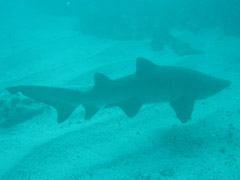
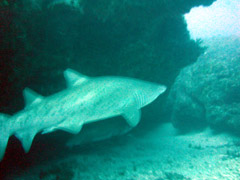
Raggies on sand
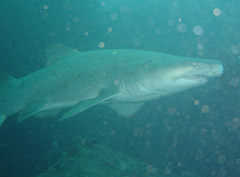
Raggie with chopped-off nose!
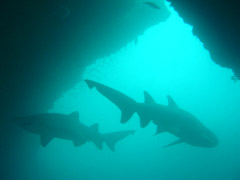
Entrance to 'Cathedral Cave'

Half-tuna left by tiger shark

Humpback whale tail
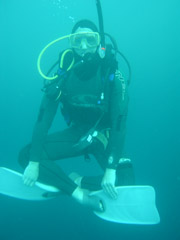
Underwater yoga (Adam) !
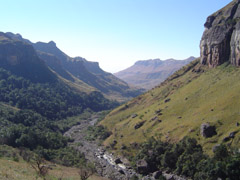
View from our hike in Royal Natal N.P.
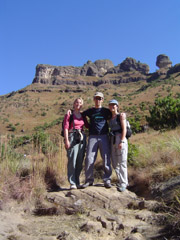
Team pic before Ads caught up
|